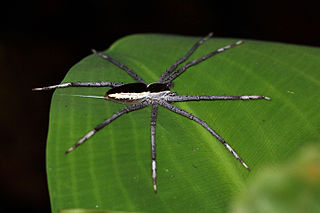
Nursery web spiders (Pisauridae) is a family of araneomorph spiders first described by Eugène Simon in 1890. They resemble wolf spiders (Lycosidae) except for several key differences. Wolf spiders have two very prominent eyes in addition to the other six, while a nursery web spider's eyes are all about the same size. Additionally, female nursery web spiders carry their egg sacs with their jaws and pedipalps instead of attaching them to their spinnerets as wolf spiders do. When the eggs are about to hatch, a female spider builds a nursery "tent", places her egg sac inside, and stands guard outside, hence the family's common name. Like the wolf spiders, however, the nursery web spiders are roaming hunters that don't use webs for catching prey. They have a wide variety of prey, and larger species may prey upon vertebrates, particularly amphibians and fish.

Lynx spider (Oxyopidae) is a family of araneomorph spiders first described by Tamerlan Thorell in 1870. Most species make little use of webs, instead spending their lives as hunting spiders on plants. Many species frequent flowers in particular, ambushing pollinators, much as crab spiders do. They tend to tolerate members of their own species more than most spiders do, and at least one species has been identified as exhibiting social behaviour.

The wafer trapdoor spiders, family Cyrtaucheniidae, are a widespread family of spiders that lack the thorn-like spines on tarsi and metatarsi I and II found in true trapdoor spiders (Ctenizidae).

Atypidae, also known as atypical tarantulas or purseweb spiders, is a spider family containing only three genera. They are accomplished ambush predators that spend most of their time in a sock-like, silken retreat on the ground from where they kill their prey.
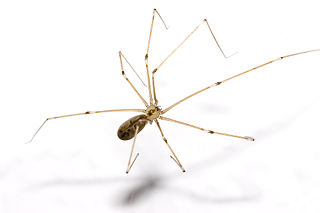
The Pholcidae are a family of araneomorph spiders. The family contains over 1,800 pholcids, including those commonly known as the marbled cellar spider , daddy long-legs spider, granddaddy long-legs spider, carpenter spider, daddy long-legger, vibrating spider, gyrating spider, long daddy, and skull spider. The family, first described by Carl Ludwig Koch in 1850, is divided into 94 genera.
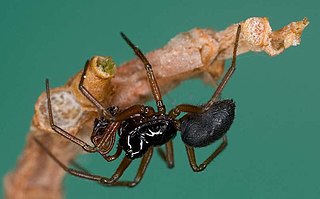
Erigoninae are the largest subfamily of sheet weavers (Linyphiidae), which is itself the second largest spider family. In the United States they are known as dwarf spiders, while they are called money spiders in England. The exact taxonomic limits of the subfamily are not yet known.

Crevice weaver spiders (Filistatidae) comprise cribellate spiders with features that have been regarded as "primitive" for araneomorph spiders. They are weavers of funnel or tube webs. The family contains 18 genera and more than 120 described species worldwide.

The southern house spider is a species of large spider in the family Filistatidae. Currently given the scientific name Kukulcania hibernalis, it was formerly known as Filistata hibernalis. Found in the Americas, it exhibits strong sexual dimorphism. It is occurs in the southern states of the USA, throughout Central America and some of the Caribbean, to southern Brazil, Uruguay and Argentina. The males may be mistaken for brown recluses because the two have similar coloration and body structure. However, compared to the brown recluse, male southern house spiders are typically larger in size, lack the distinctive violin shape on their cephalothorax, and have unusually long slender pedipalps. The females are dark brown or black and more compact. Both sexes may grow to be roughly 2 inches (5.1 cm) across, with the males typically having longer legs, and the females often having larger, bulbous bodies. The abdomen of the southern house spider is covered with fine velvety light gray hair.
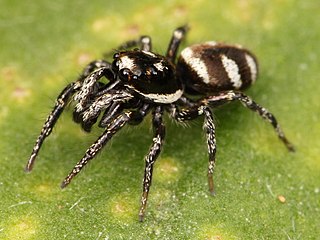
The zebra spider is a common jumping spider of the Northern Hemisphere. Like other jumping spiders it does not build a web. It has a particularly large pair of forward facing eyes that help it to locate and stalk its prey before pouncing on it. Their common name refers to their vivid black-and-white colouration, whilst their scientific name derives from Salticus from the Latin for “dancing”, in reference to their agility, and the Greek scenicus, translating to “theatrical” or “of a decorative place,” in reference to the flashy, zebra-like coloration of the species.
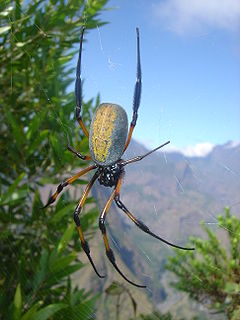
Trichonephila inaurata,, commonly known as the red-legged golden orb-weaver spider or red-legged nephila, is a species of orb-weaver spider of the genus Trichonephila. It is native to southern and East Africa, as well as several islands of the western Indian Ocean.
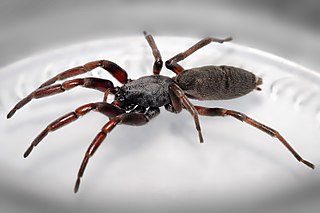
White-tailed spiders are spiders native to southern and eastern Australia, and so named because of the whitish tips at the end of their abdomens. The body size is up to 18 mm, with a leg-span of 28 mm. Common species are Lampona cylindrata and Lampona murina. Both these species have been introduced to New Zealand.
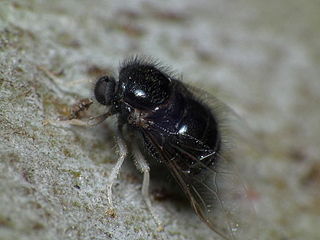
The Acroceridae are a small family of odd-looking flies. They have a hump-backed appearance with a strikingly small head, generally with a long proboscis for accessing nectar. They are rare and not widely known. The most frequently applied common names are small-headed flies or hunch-back flies. Many are bee or wasp mimics. Because they are parasitoids of spiders, they also are sometimes known as spider flies.

Phidippus audax is a common jumping spider of North America. It is commonly referred to as the daring jumping spider, or bold jumping spider. The spider belongs to the genus Phidippus, a group of jumping spiders easily identified both by their relatively large size and their iridescent chelicerae.

Larinioides cornutus, the furrow spider, furrow orb spider, or foliate spider is an orb-weaver spider with Holarctic distribution.

Gasteracantha cancriformis is a species of orb-weaver spider. It is widely distributed in the New World.
Pierre Bonnet was a French arachnologist who wrote Bibliographia Araneorum, an immense work listing publications on spiders. It was the result of forty years of work.

Spiders are air-breathing arthropods that have eight legs, chelicerae with fangs generally able to inject venom, and spinnerets that extrude silk. They are the largest order of arachnids and rank seventh in total species diversity among all orders of organisms. Spiders are found worldwide on every continent except for Antarctica, and have become established in nearly every habitat with the exceptions of air and sea colonization. As of July 2019, at least 48,200 spider species, and 120 families have been recorded by taxonomists. However, there has been dissension within the scientific community as to how all these families should be classified, as evidenced by the over 20 different classifications that have been proposed since 1900.
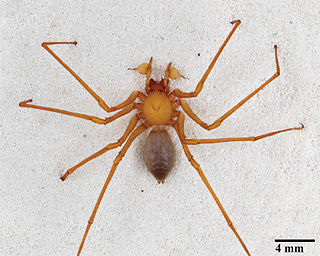
Trogloraptor is a genus of large spiders found in the caves of southwestern Oregon. It is the sole genus in the family Trogloraptoridae, and includes only one species, Trogloraptor marchingtoni. These spiders are predominantly yellow-brown in color with a maximum leg span of 3 in (7.6 cm). They are remarkable for having hook-like claws on the raptorial last segments of their legs.
Filistata maguirei is a species of the araneomorph spider family Filistatidae.
















